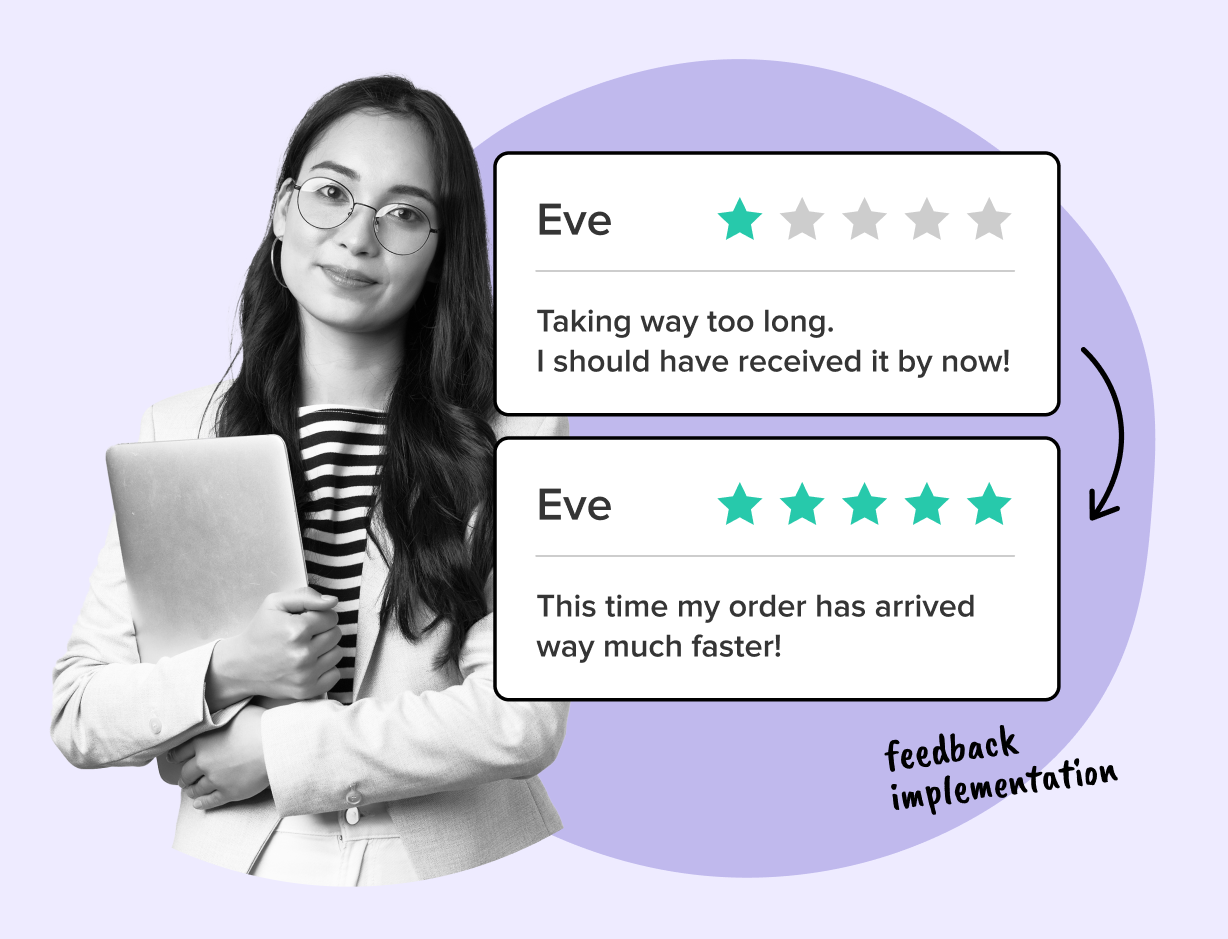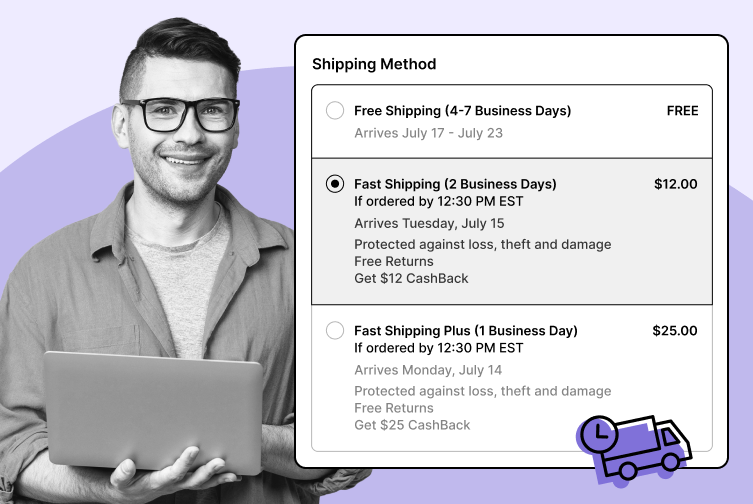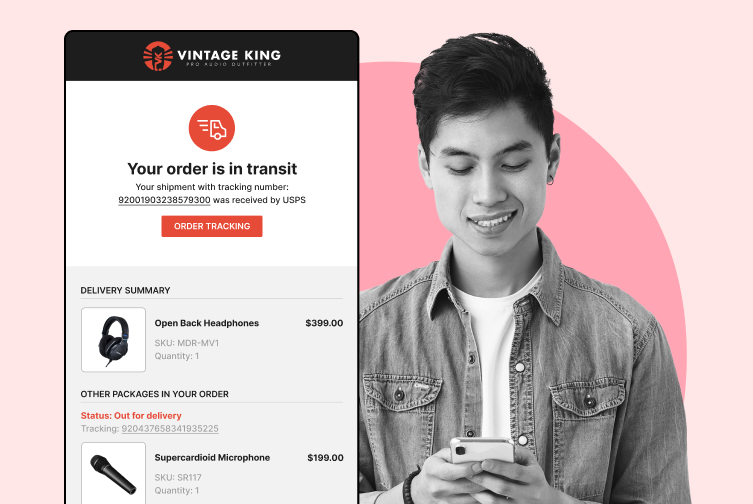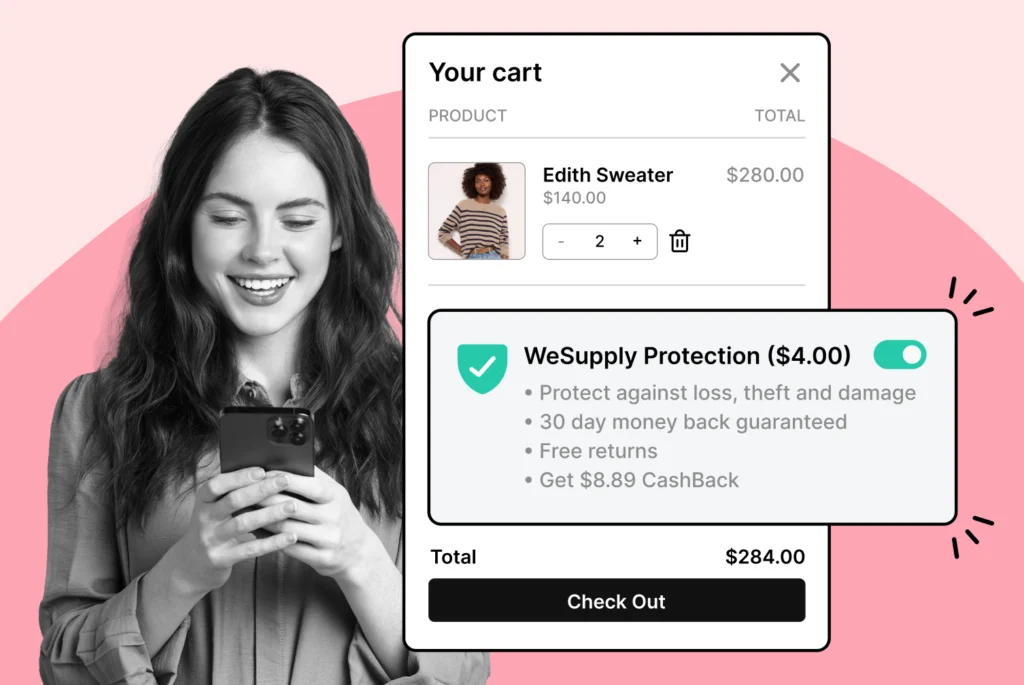
Shipping Optimization to Reduce Return and Boost Margins
Discover effective shipping optimization strategies to lower return rates and costs. Enhance your logistics today!
Shipping, Tracking & Notifications
Boost customer experience and reduce support tickets
Realtime order and shipment tracking
Proactive order and shipping notifications
AI-Enhanced Discounted Labels
Predictive pre-purchase estimated delivery dates
Self-Serivce branded order tracking
Effortless experience delivered
Identify and Resolve Order Issues
Realtime order and shipment tracking
Make returns profitable and delight customers
Flexibility to define any return destinations & conditions
Simplify returns for your customers and team
Incentivize exchanges over returns
Returns management made easy for your team
Returns management made easy for your team
Easy claims and smart upsells
Understand why your customers are returning
In-Store & Curbside Pickup
Unify the online and the in-store experience
Hassle-free pickup experience for customers
In-Store dashboard to keep operations streamlined
In-Store and Online orders unified
Drive foot-traffic to your stores
Shipping, Tracking & Notifications
Boost customer experience and reduce support tickets
Realtime order and shipment tracking
Proactive order and shipping notifications
AI-Enhanced Discounted Labels
Predictive pre-purchase estimated delivery dates
Self-Serivce branded order tracking
Effortless experience delivered
Identify and Resolve Order Issues
Realtime order and shipment tracking
Make returns profitable and delight customers
Flexibility to define any return destinations & conditions
Simplify returns for your customers and team
Incentivize exchanges over returns
Returns management made easy for your team
Returns management made easy for your team
Understand why your customers are returning
In-Store & Curbside Pickup
Unify the online and the in-store experience
Hassle-free pickup experience for customers
In-Store Dashboard to keep operations streamlined
In-Store and Online orders unified
Drive foot-traffic to your stores
Boost customer experience and reduce support tickets
Realtime order and shipment tracking
Proactive order and shipping notifications
AI-Enhanced Discounted Labels
Predictive pre-purchase estimated delivery dates
Self-Serivce branded order tracking
Effortless experience delivered
Make returns profitable and delight customers
Flexibility to define any return destinations & conditions
Simplify returns for your customers and team
Incentivize exchanges over returns
Returns management made easy for your team
Equip your team for precise return checks.
Easy claims and smart upsells
Understand why your customers are returning
Unify the online and the in-store experience
Hassle-free pickup experience for customers
In-Store Dashboard to keep operations streamlined
In-Store and Online orders unified
Drive foot-traffic to your stores
Find the answer to all your questions
Take a step by step trip through our functionality to see how we can improve your ecommerce processes.
Explore the most comon questions about WeSupply
Calculate the ROI that WeSupply can bring you
Read actionable articles on how to optimize your post-purchase experience and decrease support tickets
Get inspired by stories of how our customers implemented an effortless post-purchase experience
Wondering if WeSupply is a good fit for you? Read through our use cases to see how we can help you increase conversion & improve CX!
A Deep Dive into Top Companies' Order Tracking & Returns Strategy
Find the answer to all your questions
Explore the most comon questions about WeSupply
Calculate the ROI that WeSupply can bring you
Request a no strings attached review of your current shopping experience and missed conversion opportunities
Take a step by step trip through our functionality to see how we can improve your ecommerce processes.
Read actionable articles on how to optimize your post-purchase experience and decrease support tickets
Get inspired by stories of how our customers implemented an effortless post-purchase experience
A Deep Dive into Top Companies' Order Tracking & Returns Strategy
Wondering if WeSupply is a good fit for you? Read through our use cases to see how we can help you increase conversion & improve CX!

In the fast-moving world of ecommerce, shipping isn’t just a backend operation, it’s the final, crucial impression a customer has of your brand. It can be the difference between a satisfied, loyal shopper and one who never returns. Despite this, many businesses still treat shipping as an afterthought, focusing more on front-end experiences like web design and marketing, while neglecting the moment when the customer finally receives their order.
The reality is this: poor shipping has a tangible cost. It leads to lost sales, negative reviews, and high customer churn. And beyond these direct consequences, it quietly chips away at profitability through returns, operational inefficiencies, and mounting customer service overhead. Rising costs of shipping items impact companies of all sizes, from small businesses to large corporations, making it even more important to address shipping challenges strategically. In this article, we’ll unpack exactly how poor shipping affects your business and what you can do to turn it into a strategic advantage.
In today’s e-commerce landscape, shipping costs are more than just a line item they’re a make-or-break factor for your business. As online shopping becomes the norm, customer expectations for fast and free shipping have skyrocketed. Shoppers now demand quick, affordable delivery, and if your shipping rates or delivery speeds don’t measure up, they’ll simply take their business elsewhere. This puts immense pressure on businesses to offer competitive shipping fees while still protecting their bottom line.
The average shipping cost for an order can fluctuate dramatically based on package size, weight, shipping zones, and the chosen carrier. Calculating dimensional weight has become a standard practice among shipping carriers, making it essential for businesses to optimize their packaging and shipping process. For smaller packages, USPS Priority Mail or flat rate shipping options can help reduce shipping costs and simplify pricing for both you and your customers. On the other hand, ground shipping or working with multiple carriers may be the smarter choice for larger or heavier shipments, especially when delivering to different regions or the West Coast.
To stay ahead, businesses must master the complexities of shipping carriers, rate changes, and fulfillment strategies. This means understanding how to calculate shipping fees, leverage free packaging, and use fulfillment centers to minimize shipping zones and speed up deliveries. Tools like Shopify Shipping can streamline the process, helping you compare rates, print labels, and track shipments all while keeping costs in check.
Reducing shipping costs isn’t just about saving money; it’s about meeting customer expectations and driving more sales. Offering perks like fast and free shipping, or even flat rate shipping, can boost your conversion rate and average order value. Meanwhile, optimizing your shipping process and staying informed about rate changes ensures you’re not caught off guard by rising carrier costs or unexpected delays.
Whether you’re a small business just starting out or an established e-commerce brand, understanding and managing your shipping costs is crucial. In the sections that follow, we’ll explore proven strategies to reduce shipping costs, the benefits of using multiple carriers, and how to track shipments and adapt to changing shipping rates. By taking control of your shipping strategy, you can deliver a better experience for your customers, increase your sales, and keep your business profitable in a fiercely competitive market.
Let’s start with the most visible impact: lost sales. The connection between poor shipping and lost revenue is direct and severe. When shipping costs are too high, options are too limited, or delivery speeds don’t meet expectations, customers abandon their carts. In fact, research shows that 48% of shoppers will abandon their cart due to high or unexpected shipping fees. Offering free shipping can attract more customers and encourage them to complete their purchase, reducing cart abandonment and boosting sales. For retailers, that’s a major blow at the final step of the conversion funnel.
Even if a customer makes it past checkout, shipping issues can still derail the sale. Failed deliveries caused by incorrect addresses, poor carrier performance, or damage in transit often lead to canceled orders and refunds. And unfortunately, customers don’t always come back to try again.
Adding to the problem is competitor pressure. With ecommerce giants like Amazon offering free two-day shipping as the norm, customers have little patience for delays. These companies set expectations for cheaper and faster delivery options, making it harder for smaller retailers to compete. Even if your product is superior, a competitor with better shipping options is likely to win the sale. Simply put, poor shipping is one of the fastest ways to lose customers before they even experience your product.
Free and flat-rate shipping are powerful tools for increasing conversions, but they need to be implemented wisely. Free shipping boosts average order value and encourages purchases, but it must be balanced with costs. Offering free shipping or express delivery can incentivize customers to add more items to their cart, increasing the average order value and overall sales. Flat-rate shipping simplifies choices and can also lead to larger baskets, as customers try to get the most value out of a single shipment. When implemented strategically, these options can help you recover the revenue that poor shipping otherwise costs you. To maintain profitability while you offer free shipping, your company may need to adjust product price or product prices to offset shipping expenses.
Negative customer reviews have always been dangerous for businesses, but in the digital age, their impact is amplified. With platforms like Google, Amazon, and Trustpilot indexing every opinion, one bad shipping experience can quickly damage your brand’s reputation.
Shipping-related complaints are among the most common drivers of negative reviews. Customers frustrated by delays, damaged items, or vague tracking often take to the internet to air their grievances. Unhappy customers, especially those affected by shipping delays, may leave negative reviews that can harm your retail reputation. Unlike product quality issues, which some shoppers might overlook or forgive, poor shipping affects the entire experience and customers tend to hold the seller accountable.
A consistent pattern of bad reviews doesn’t just scare away new customers. It can also drag down your search engine rankings and reduce your visibility on platforms that rely on customer ratings for product placement. If your shipping processes regularly lead to customer dissatisfaction, they’re likely undermining all the work you’ve done on SEO, PPC, and social marketing.
The erosion of trust is another serious consequence. When a business repeatedly fails to deliver on shipping promises, customers stop believing what it says. Even loyal customers might hesitate to buy again if they suspect their package will arrive late or damaged. In many cases, the expectation of fast and transparent shipping is stronger than brand loyalty itself.
Fortunately, you can flip the script. Transparent communication, reliable delivery, and proactive tracking updates help prevent bad experiences. Even when issues do arise, offering fast and empathetic customer service can turn a potential bad review into a positive one.
While a single shipping delay might not lose a customer forever, repeated issues almost certainly will. Poor shipping chips away at the trust and satisfaction that drive long-term customer relationships. It’s one of the biggest contributors to customer churn and many businesses don’t even realize it.
Customer churn is expensive. It costs five to seven times more to acquire a new customer than to retain an existing one. Yet 84% of consumers say they won’t return to a retailer after a poor returns experience, and 42% would cancel a subscription if free shipping were no longer offered. These statistics make it clear: unreliable shipping doesn’t just cause momentary frustration. It drives people away for good.
Worse, dissatisfied customers don’t stay silent. They often share their experiences with friends, family, and social networks, multiplying the damage. Word-of-mouth is powerful, and a single negative shipping story can dissuade dozens of potential buyers.
On top of that, poor shipping significantly increases customer service workload. Late deliveries, tracking issues, and return problems flood your support team with inquiries, stretching resources and increasing operational costs. This internal pressure adds yet another layer to the total cost of churn.
If you want to build customer loyalty and lifetime value, you have to get shipping right. Fast, accurate, and predictable delivery reassures customers, builds confidence, and encourages repeat purchases. Customers are less likely to keep paying for repeat purchases if your store consistently fails to deliver on shipping promises. Optimizing your store’s shipping processes is essential to retain loyal customers and reduce churn.
Beyond the visible losses of sales, reputation, and loyalty, poor shipping comes with a host of hidden costs that quietly erode profit margins. Returns, for instance, are often seen as a customer service issue, but they’re frequently caused by shipping problems like damage, delays, or misdeliveries. Analyzing order history and optimizing the supply chain can help lower costs and reduce unnecessary returns.
Industry data shows that ecommerce return rates hover around 14.5% to 17.6% of total sales. That means for every $1 billion in revenue, businesses deal with $145 to $176 million in returns. While some returns are unavoidable, many can be reduced through better packaging, more accurate order fulfillment, and reliable carriers.
Packaging itself is a major contributor to cost. Oversized or inefficient packaging leads to higher dimensional weight charges from carriers, while flimsy materials increase the risk of damage and returns. Using a postage scale and learning to calculate dimensional weight accurately are essential steps to achieve lower shipping costs. Lightweight, right-sized, durable packaging can dramatically reduce both shipping and replacement costs.
Then there are operational overheads: expedited re-shipping, last-minute carrier surcharges, storage fees for undelivered items, and penalties from missed delivery windows. Rising freight rates and longer transit times can further increase the overall cost of getting products shipped to customers. When added together, these extra costs create significant profit leakage.
Finally, poor shipping undermines retention and low retention rates drag down your entire business model. If you’re constantly losing customers due to poor delivery experiences, you’re forced to spend more on acquisition just to maintain growth. That cycle isn’t sustainable.
So how do you break the cycle of poor shipping and its compounding costs? It starts with your fulfillment strategy. A smart, flexible, and data-driven approach to fulfillment can drastically improve shipping outcomes.
Using fulfillment centers strategically especially those located closer to your customers can shorten delivery times and reduce shipping zones. This not only speeds up the customer experience but also lowers transportation costs. Many ecommerce brands now use multiple warehouses or third-party logistics (3PL) partners to gain regional coverage and scalability.
Choosing the right shipping partners is just as critical. Not all carriers are created equal. Factors like on-time delivery rates, handling care, tracking reliability, and support responsiveness should all play into your carrier decisions. Relying on just one carrier can expose your business to risks like service disruptions or missed cost-saving opportunities. Diversifying your carrier options allows you to compare shipping rates, negotiate better deals, and tailor shipping solutions to your needs. It’s also wise to regularly audit carrier performance and negotiate better rates.
Automation plays a key role here. By integrating shipping software or using tools like Shopify Shipping, you can automate label creation, track packages in real-time, and reduce human errors. Shipping rate software helps you identify the most cost-effective options from multiple carriers, manage logistics efficiently, and reduce overall shipping expenses. It’s important to stay informed about shipping rate changes, industry updates, and carrier announcements to optimize your fulfillment strategy. This not only saves time but enhances accuracy across the board.
Cutting shipping costs doesn’t have to come at the expense of customer satisfaction. In fact, a well-optimized shipping operation can lower expenses and improve the experience. The key is offering flexibility and making data-driven decisions.
Start by offering multiple shipping options. Some customers want the fastest option and are willing to pay for it. Others are happy to wait a few extra days to save money. By offering a mix of ground, express, and economy shipping, you meet different needs without alienating your base. For small businesses, creative selling strategies like bundling products or upselling premium options can help offset shipping costs and increase revenue.
Be proactive with communication. Provide estimated delivery times, tracking numbers, and status updates. This reduces anxiety and builds trust especially when delays occur.
Review shipping rates and carrier pricing regularly. Shipping rates change, and sticking with a single provider without renegotiation could mean overpaying. Adjust your product price as needed to ensure shipping expenses are covered and profit margins are protected. Consider working with multiple carriers to optimize both cost and performance.
Review shipping rates and carrier pricing regularly. Shipping rates change, and sticking with a single provider without renegotiation could mean overpaying. Adjust your product price as needed to ensure shipping expenses are covered and profit margins are protected. Consider working with multiple carriers to optimize both cost and performance.
Packaging is another opportunity. Use lightweight, durable materials, and minimize unused space to reduce dimensional weight charges. Consider using poly mailers, bubble wrap, or air pillows for protection without bulk.
Shipping insurance and order protection can also minimize risk and create a more secure customer experience. These measures not only protect your bottom line but also give customers peace of mind.
One of the most effective ways to counteract the effects of poor shipping is through clear, proactive communication. Many customer complaints stem not just from the shipping problem itself, but from being kept in the dark.
Set clear expectations from the beginning. Display estimated delivery times at checkout, send confirmation emails with tracking numbers, and offer updates when shipments are delayed. Transparency goes a long way toward maintaining trust, even when things go wrong.
When issues arise, respond quickly and empathetically. Train your support team to offer solutions—not just apologies. A small refund, expedited reshipment, or sincere follow-up message can often save a customer relationship.
Also consider using branded tracking pages that reinforce your brand identity while keeping customers informed. These pages offer a chance to cross-sell, educate, and build brand loyalty while the customer waits.
In a world where fast, accurate shipping is no longer a luxury but a customer expectation, poor delivery experiences can cost your business more than just a few packages they can drive lost sales, damage your reputation, and lead to costly customer churn. That’s where WeSupply steps in.
WeSupply transforms shipping from a cost center into a strategic advantage, helping you deliver on customer expectations while protecting your bottom line. Whether you’re dealing with cart abandonment from high shipping costs, bad reviews from delays or damaged goods, or rising support tickets due to delivery confusion WeSupply offers the tools to fix it.
Keep your customers engaged during the delivery experience
Book a quick call with our experts to see how WeSupply can help you engage your customers with relevant updates through the right channel, at the right time.
✅ Branded Tracking Pages
Keep customers in the loop with real-time, branded order tracking. Turn the post-purchase phase into an engaging, trust-building experience instead of a black box.
✅ Proactive Delivery Notifications
Send automated alerts via email or SMS for every order update from label creation to doorstep delivery reducing WISMO inquiries and customer frustration.
✅ AI-Powered Delivery Estimates
Display accurate delivery timelines based on data, not guesswork. This boosts customer confidence and helps prevent negative reviews when orders take longer than expected.
✅ Multi-Carrier Integration
Connect all your carriers (FedEx, UPS, USPS, etc.) to one platform. Gain visibility into performance and dynamically route shipments to ensure timely and cost-effective delivery.
✅ Shipping Incident Detection
Identify delivery exceptions like delays, lost packages, or failed handoffs before the customer does. Automatically trigger recovery workflows to protect satisfaction and loyalty.
✅ Returns & Exchanges Portal
Turn returns from a loss into an opportunity. Let customers easily initiate returns or exchanges while you track the root cause like damages due to poor packaging or shipping errors.
✅ Order Protection & Shipping Insurance Integration
Offer peace of mind with order protection add-ons that reduce the impact of lost or damaged goods and keep your customer relationships intact.
✅ Curbside & In-Store Pickup Support to enable hybrid fulfillment models like BOPIS and local delivery.
In short, WeSupply helps ecommerce businesses avoid the hidden costs of poor shipping by delivering clarity, speed, and consistency all of which translate into fewer bad reviews, lower churn, and more repeat customers.
Don’t let a broken delivery experience undo all the work you’ve put into acquisition and conversion. With WeSupply, you can ship smarter, retain more customers, and protect your brand’s reputation all while reducing operational overhead. Book a demo with WeSupply!
Combat inconvenience with proactivity & self service
Book a quick call with our experts to see how WeSupply can help you make returns easy for your customers with a beautiful, self-service solution that makes their experience easier while also providing new ways to lower costs and earn back revenue.
he cost of poor shipping goes far beyond a few delayed or lost packages it impacts your sales, reputation, customer loyalty, and internal resources. But with the right tools and strategy, shipping doesn’t have to be a liability. It can be a powerful driver of growth and trust. That’s where WeSupply comes in.
By giving your customers real-time, branded tracking updates, accurate delivery estimates, and proactive notifications, WeSupply ensures transparency throughout the post-purchase journey. When issues arise, its delivery incident detection alerts your team before customers even notice, giving you the chance to step in, resolve problems, and protect satisfaction. With seamless multi-carrier integration and a powerful returns and exchanges portal, you can reduce operational overhead while enhancing flexibility and convenience for your shoppers.
WeSupply even integrates with your helpdesk, equipping your support team with real-time delivery insights to resolve shipping questions fast no more switching between platforms or asking customers to repeat themselves. Add in order protection options and AI-powered delivery timelines, and you have a complete post-purchase experience that builds confidence, minimizes complaints, and keeps customers coming back.
In 2025 and beyond, ecommerce success will go to brands that treat shipping as an experience, not an afterthought. With WeSupply, you’re not just shipping products you’re delivering on your promise, every step of the way.
1. What are the main costs of poor shipping in ecommerce?
Poor shipping leads to lost sales, bad reviews, higher customer churn, and increased operational costs from returns, reships, and customer service inquiries. It also erodes customer trust and damages your brand reputation.
2. How does poor shipping cause customer churn?
When customers experience late, damaged, or missing deliveries repeatedly, they lose trust and stop buying. Unreliable shipping is a top reason shoppers don’t return even if the product quality is good.
3. Why do high shipping costs lead to cart abandonment?
Shoppers often abandon carts when faced with unexpected or high shipping fees. Transparent, affordable options like free or flat-rate shipping help reduce abandonment and boost conversion.
4. How does WeSupply help reduce customer churn?
WeSupply provides branded tracking, proactive delivery alerts, and shipping incident detection keeping customers informed and reducing frustration that leads to churn.
5. Can WeSupply help lower support tickets about shipping?
Yes. With real-time tracking and automated delivery updates, WeSupply significantly reduces “Where is my order?” (WISMO) inquiries, freeing up your support team.
6. Does WeSupply work with multiple shipping carriers?
Absolutely. WeSupply integrates with FedEx, UPS, USPS, and more, giving you real-time visibility and helping you optimize shipping for speed and cost-efficiency.
7. Does WeSupply have an Official Shopify App?
Yes. WeSupply has an Official Shopify App. You can download it and start integrating with your Shopify Store.
8. Does WeSupply have an official Magento extension?
Yes, WeSupply has an official extension for Magento. The WeSupply x Magento integration allows for automating order tracking experiences, reducing customer inquiries, automating shipping email and SMS notifications, and providing a fully branded order tracking experience
9. Does WeSupply have an official BigCommerce App?
Yes, WeSupply has an official BigCommerce App. You can integrate WeSupply with your BigCommerce store to improve your post-purchase customer experience.
Learn How To Create Successful Post Purchase Email Campaigns
Build an effective post-purchase email flow that helps you increase customer satisfaction and drive revenue growth!

Discover effective shipping optimization strategies to lower return rates and costs. Enhance your logistics today!

Explore how shipping affects customer satisfaction and loyalty. Understand the key factors that influence their experience. Read the article to learn more.

Learn how dynamic shipping rates at checkout can enhance pricing strategies and improve customer satisfaction. Discover practical tips in our article.

Effective strategies for communicating shipping delays to keep customers informed and satisfied. Enhance your customer service approach!

Discover effective strategies to manage split shipments, reduce delays, and enhance customer satisfaction. Practical solutions!

Discover how enhanced estimated delivery dates can boost your e-commerce sales. Learn practical strategies to improve customer satisfaction today!
Master unified tracking for split or multi shipment orders with our comprehensive guide. Streamline your process and improve efficiency—read more now!

Learn effective strategies for handling shipment exceptions and improving customer communication. Read the article for practical tips and insights.

Discover how effective shipping insurance integration can enhance your business efficiency and protect your assets. Read the article for practical insights.